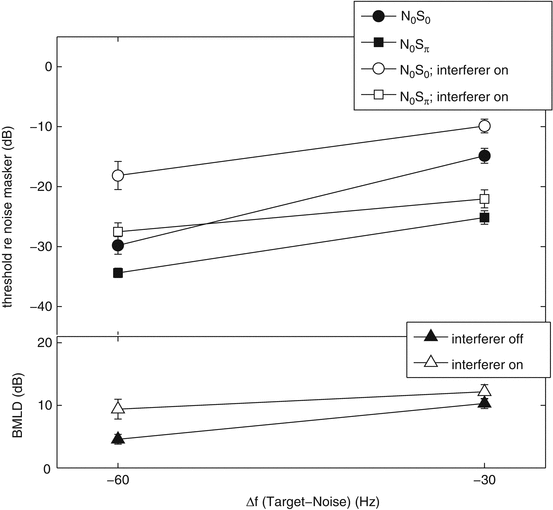Fig. 33.1
The top panel shows N 0 S 0 (circles) and N 0 S π (squares) thresholds as a function of the frequency separation between target and noise masker for conditions without interferer (filled symbols) and with interferer (open symbols). The lower panel shows corresponding BMLD values
In the conditions with interferer (open symbols), both N 0 S 0 (circles) and N 0 S π (squares) thresholds increase relative to the condition without interferer. The increase in N 0 S 0 thresholds was expected since the interferer should reduce the processing of monaural modulation cues and/or distortion products. Due to the presentation level of the interferer that was 6 dB lower than the masker, it is not expected that additional energetic masking will occur. The increase in N 0 S π thresholds was not expected because the interferer should only affect monaural processing. Such an increase is, however, consistent with the idea that in the off-frequency condition, N 0 S π detection thresholds were predominantly based on monaural processing, that is, that also in N 0 S π conditions, monaural cues could be detected at lower target-to-masker ratios than binaural cues.
3 Experiment II: Target Tone Placed at a Frequency Below the Masker
The second experiment extends the previous one by presenting target below the masker and the interferer above the masker. This rearrangement allows us to estimate the level that distortion products could have on the premise that they are the main cue for target detection in the off-frequency N 0 S 0 conditions without interferer.
3.1 Stimulus and Method
Besides the exchange in spectral position of target and interferer, all other experimental details are the same as in the previous experiment. Masker-target separations of 100 Hz were not measured.
3.2 Results and Discussion
The results of the second experiment are shown in Fig. 33.2 in the same manner as in Fig. 33.1. In off-frequency conditions without interferer, there exists a somewhat larger BMLD than in the previous experiment. The presence of the interferer leads to an increase in the N 0 S 0 and the N 0 S π thresholds, but this increase is now smaller, in particular for the N 0 S π thresholds. As in the first experiment, these results are in line with the hypothesis that the usage of modulation cues is reduced by the presence of the interferer.


Fig. 33.2
Similar to Fig. 33.1, now with the interferer placed above the masker and the target tone below the masker
The data obtained in this experiment allows us to make an estimate for the maximum level of the distortion products in the configuration of Experiment 1. For this purpose, the distortion products are first analyzed for Experiment 2, where they are generated by the interaction between masker and interferer. The resulting distortion products would spectrally overlap with the target and could thus serve as an additional on-frequency masker. If the observed masked thresholds indeed reflect such a process, the levels of the distortion products can be estimated by assuming that they should be about equal to the masked threshold (SNR 0 dB at threshold). In Fig. 33.2, these masked thresholds (open circles) amount to 45 dB SPL for Δf = −60 Hz and 55 dB SPL for Δf = −30 Hz.
In the first experiment, these distortion products are not generated by the 59 dB SPL interferer but by the target tones. These target tones had N 0 S 0 thresholds of 36 and 50 dB SPL for Δf of 60 and 30 Hz, respectively. Assuming that the level of the distortion products scales linearly with the level of the tonal component above the masker, the levels of the distortion components in Experiment I should be 22 dB SPL for Δf = 60 Hz and 46 dB SPL for Δf = 30 Hz in the N 0 S 0 condition without interferer.
Stay updated, free articles. Join our Telegram channel

Full access? Get Clinical Tree


